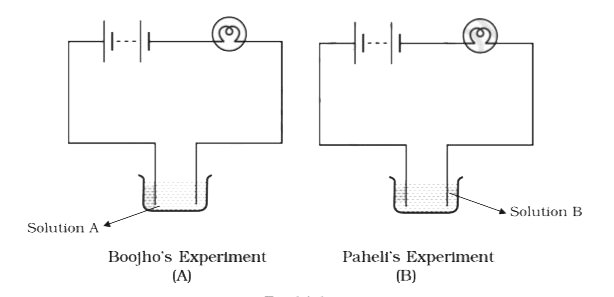A tester is used to check the conduction of electricity through two liquids, labelled A and B. It is found that the bulb of the tester glows brightly for·liquid A while it glows very dimly for liquid B. What conclusion would you draw?
liquid A is a better conductor than liquid B.
liquid B is a better conductor than liquid A.
both liquids are equally conducting
conducting properties of liquid cannot be compared in this manner.
Step-by-Step Solution:
1. Understanding the Tester: A tester is an instrument used to check the conduction of electricity through different materials, in this case, two liquids labeled A and B.
2. Observing the Results: When the tester was used with liquid A, the bulb glowed brightly. This indicates that a significant amount of electric current is flowing through liquid A. In contrast, when liquid B was tested, the bulb glowed very dimly, suggesting that only a small amount of electric current is flowing through liquid B.
3. Interpreting the Brightness of the Bulb: The brightness of the bulb in the tester is directly related to the conductivity of the liquid. A bright glow indicates high conductivity, meaning that the liquid allows electric current to pass through it easily. A dim glow indicates low conductivity, meaning the liquid does not allow electric current to pass through it effectively.
4. Drawing a Conclusion: Based on the observations:
- Since liquid A allows more current to flow (bulb glows brightly), it is a better conductor of electricity compared to liquid B, which allows less current to flow (bulb glows dimly).
- Therefore, we conclude that liquid A is a better conductor of electricity than liquid B.
Conclusion:
Liquid A is a better conductor of electricity than liquid B, as evidenced by the brightness of the bulb in the tester.
---
- Since liquid A allows more current to flow (bulb glows brightly), it is a better conductor of electricity compared to liquid B, which allows less current to flow (bulb glows dimly).
- Therefore, we conclude that liquid A is a better conductor of electricity than liquid B.
Liquid A is a better conductor of electricity than liquid B, as evidenced by the brightness of the bulb in the tester.
Similar Questions
A tester is used to check the conduction of electricity through two liquids, labelled A and B. It is found that the bulb of the tester glows brightly for liquid A while it glows very dimly for liquid B. You would conclude that
(i) liquid A is a better conductor than liquid B.
(ii) liquid B is a better conductor than liquid A.
(iii) both liquids are equally conducting.
(iv) conducting properties of liquid cannot be compared in this manner.
View SolutionUsing the 'conduction tester on an objectit was found that the bulb begins to glow. Is that object a conductor or an insulator? Explain.
View Solution
Knowledge Check
A tester is used to check the conduction of electricity through two liquids, labelled A and B. It is found that the bulb of the tester glows brightly for·liquid A while it glows very dimly for liquid B. What conclusion would you draw?
Aliquid A is a better conductor than liquid B.Bliquid Bis a better conductor than liquid A.Cboth liquids are equally conducting.Dconducting properties of liquid cannot be compared.
Boojho and Paheli performed experiments taking similar bulbs and cells but two different solutions A and B as shown in Fig.14.1.

They found that the bulb in the setup A glows more brightly as compared to that of the setup B. You would conclude that.
View SolutionUsing the ‘conduction tester’ on an object, it was found that the bulb begins to glow. Is the object a conductor or an insulator? Explain.
View SolutionUsing the 'conduction tester on an objectit was found that the bulb begins to glow. Is that object a conductor or an insulator? Explain.
View SolutionTwo identical containers A and B are filled with two different liquids of equal masses. The level of the liquid in container A is found to be one-fourth of the level of the liquid in container B. What is the ratio of thedensity of two liquids? If the density of he liquid in the container A is 2 " g "cm−3, then find the density of the mixture of the two liquids.
View SolutionTwo identical containers A and B are filled with two different liquids of equal masses. The level of the liquid in container A is found to be one-fourth of the level of the liquid in container B. What is the ratio of thedensity of two liquids? If the density of he liquid in the container A is 2 " g "cm−3, then find the density of the mixture of the two liquids.
View SolutionFig. 12.10 A and B, show a bulb connected to a cell in two different ways.

(i) What will be the direction of the current through the bulb in both the cases. (Q to P or P to Q)
(ii) Will the bulb glow in both the cases?
(iii)Does the brightness of the glowing bulb depend on the direction of current through it?
View SolutionWhen extremely small particles X derived from the anther of a flower were suspended in a liquid Y and observed through a microscope, it was found that the particles X were moving throughout the liquid Y in a very zig-zag way. It was also observed that warmer the liquid Y, faster the particles X moved on its surface.
What could particles X be ?
(b) What do you think liquid Y is ?
(c ) What is zig-zag movement of X known as ?
(d) What is causing the zig-zag movement of particles X ?
(e) Name the scientist who discovered this phenomenon.
(f) What does this experiment tell us about the nature of liquid Y ?
View Solution
